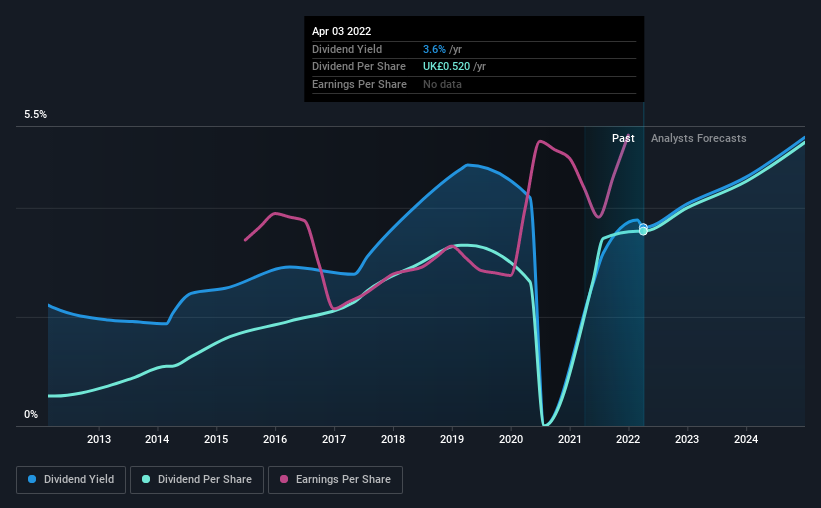St. James's Place's (LON:STJ) Dividend Will Be Increased To UK£0.40
The board of St. James's Place plc (LON:STJ) has announced that it will be increasing its dividend on the 27th of May to UK£0.40. This will take the annual payment from 3.6% to 3.6% of the stock price, which is above what most companies in the industry pay.
View our latest analysis for St. James's Place
St. James's Place's Earnings Easily Cover the Distributions
Impressive dividend yields are good, but this doesn't matter much if the payments can't be sustained. Prior to this announcement, the company was paying out 97% of what it was earning, however the dividend was quite comfortably covered by free cash flows at a cash payout ratio of only 20%. Generally, we think cash is more important than accounting measures of profit, so with the cash flows easily covering the dividend, we don't think there is much reason to worry.
Over the next year, EPS is forecast to expand by 37.3%. If the dividend continues growing along recent trends, we estimate the payout ratio could reach 75%, which is on the higher side, but certainly still feasible.
Dividend Volatility
While the company has been paying a dividend for a long time, it has cut the dividend at least once in the last 10 years. Since 2012, the first annual payment was UK£0.08, compared to the most recent full-year payment of UK£0.52. This works out to be a compound annual growth rate (CAGR) of approximately 21% a year over that time. Despite the rapid growth in the dividend over the past number of years, we have seen the payments go down the past as well, so that makes us cautious.
Dividend Growth Could Be Constrained
Given that the dividend has been cut in the past, we need to check if earnings are growing and if that might lead to stronger dividends in the future. It's encouraging to see St. James's Place has been growing its earnings per share at 20% a year over the past five years. However, the company isn't reinvesting a lot back into the business, so we would expect the growth rate to slow down somewhat in the future.
Our Thoughts On St. James's Place's Dividend
Overall, this is probably not a great income stock, even though the dividend is being raised at the moment. In the past, the payments have been unstable, but over the short term the dividend could be reliable, with the company generating enough cash to cover it. This company is not in the top tier of income providing stocks.
Market movements attest to how highly valued a consistent dividend policy is compared to one which is more unpredictable. Meanwhile, despite the importance of dividend payments, they are not the only factors our readers should know when assessing a company. Taking the debate a bit further, we've identified 3 warning signs for St. James's Place that investors need to be conscious of moving forward. If you are a dividend investor, you might also want to look at our curated list of high yield dividend stocks.
Have feedback on this article? Concerned about the content? Get in touch with us directly. Alternatively, email editorial-team (at) simplywallst.com.
This article by Simply Wall St is general in nature. We provide commentary based on historical data and analyst forecasts only using an unbiased methodology and our articles are not intended to be financial advice. It does not constitute a recommendation to buy or sell any stock, and does not take account of your objectives, or your financial situation. We aim to bring you long-term focused analysis driven by fundamental data. Note that our analysis may not factor in the latest price-sensitive company announcements or qualitative material. Simply Wall St has no position in any stocks mentioned.

 Yahoo Finance
Yahoo Finance 
